Economic Analysis of Japan and its Global Business Issues
VerifiedAdded on 2020/07/22
|8
|2544
|79
Report
AI Summary
This report provides an in-depth analysis of the economic issues facing Japan, examining its recent developments and contributions to the global economy. It explores the impact of Abenomics, including monetary and fiscal policies, and growth-enhancing structural reforms. The report highlights Japan's role in international trade and financial transactions, emphasizing its significance in global economic stability and GDP growth. Furthermore, it identifies key priorities for the Japanese government, such as regulatory reforms, economic growth, and fiscal planning, including sales tax revenue utilization for education and child care. The conclusion summarizes the core points, emphasizing how the government can apply these strategies to improve overall economic performance and its contribution to the global economy, with an emphasis on exports as a key driver of GDP growth.

ISSUES IN GLOBAL BUSINESS
Paraphrase This Document
Need a fresh take? Get an instant paraphrase of this document with our AI Paraphraser
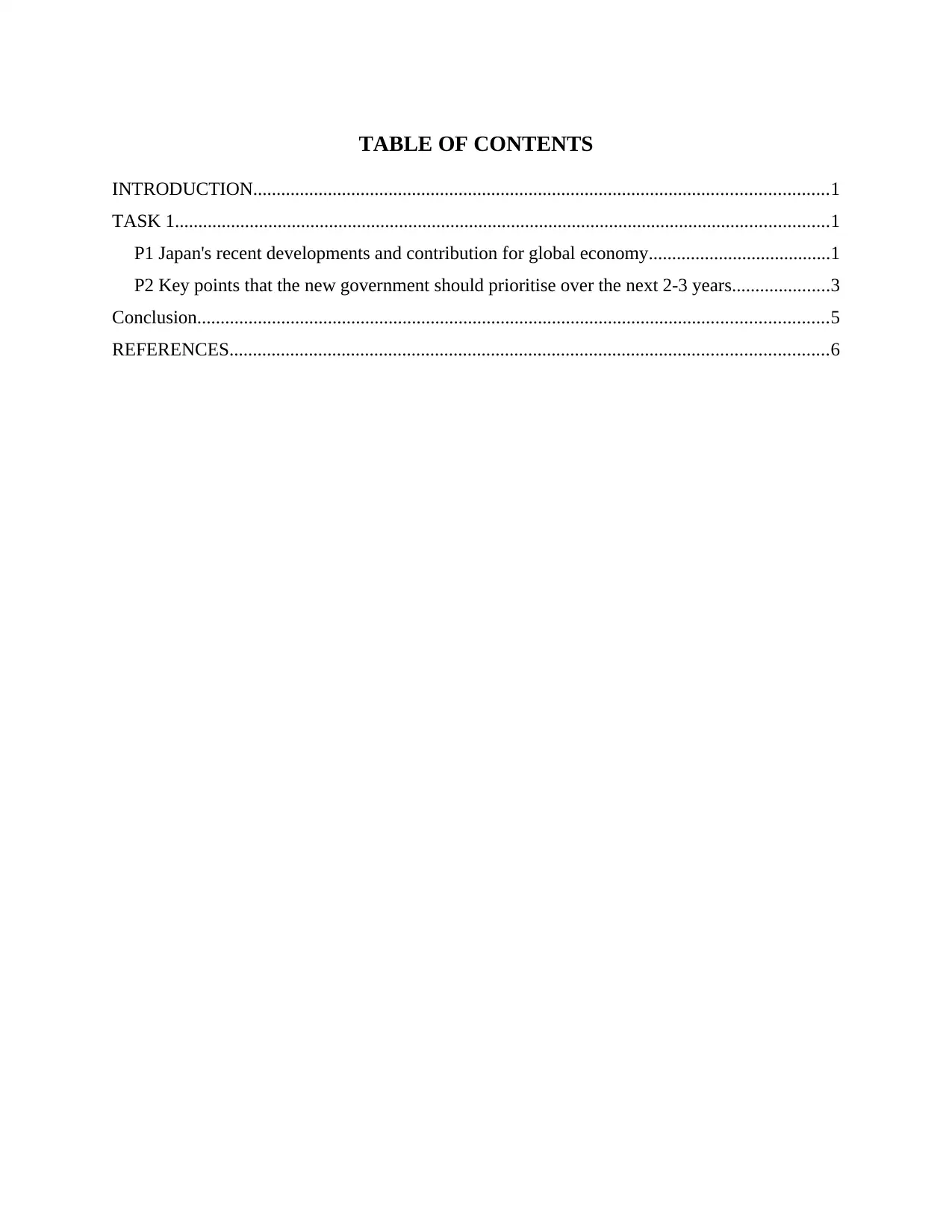
TABLE OF CONTENTS
INTRODUCTION...........................................................................................................................1
TASK 1............................................................................................................................................1
P1 Japan's recent developments and contribution for global economy.......................................1
P2 Key points that the new government should prioritise over the next 2-3 years.....................3
Conclusion.......................................................................................................................................5
REFERENCES................................................................................................................................6
INTRODUCTION...........................................................................................................................1
TASK 1............................................................................................................................................1
P1 Japan's recent developments and contribution for global economy.......................................1
P2 Key points that the new government should prioritise over the next 2-3 years.....................3
Conclusion.......................................................................................................................................5
REFERENCES................................................................................................................................6
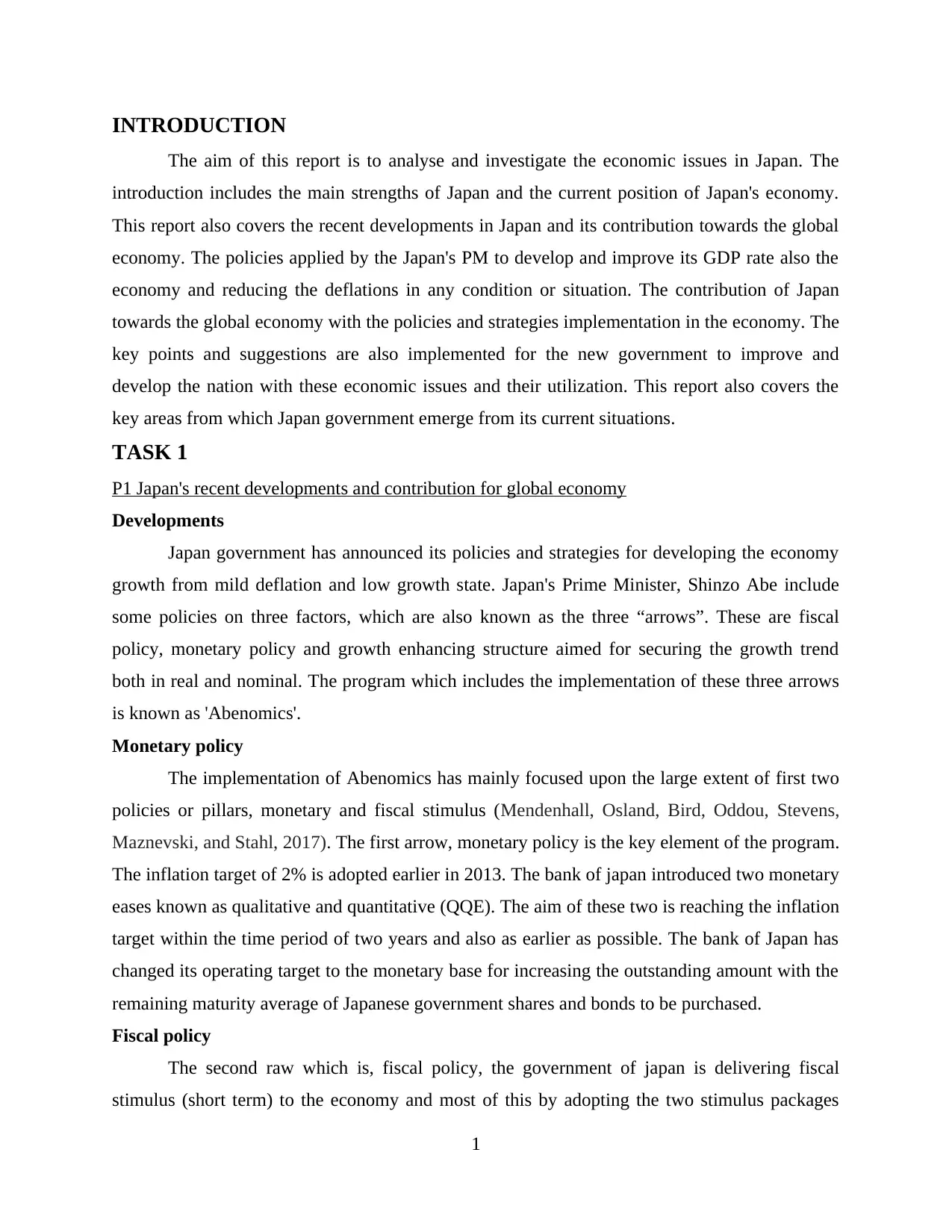
INTRODUCTION
The aim of this report is to analyse and investigate the economic issues in Japan. The
introduction includes the main strengths of Japan and the current position of Japan's economy.
This report also covers the recent developments in Japan and its contribution towards the global
economy. The policies applied by the Japan's PM to develop and improve its GDP rate also the
economy and reducing the deflations in any condition or situation. The contribution of Japan
towards the global economy with the policies and strategies implementation in the economy. The
key points and suggestions are also implemented for the new government to improve and
develop the nation with these economic issues and their utilization. This report also covers the
key areas from which Japan government emerge from its current situations.
TASK 1
P1 Japan's recent developments and contribution for global economy
Developments
Japan government has announced its policies and strategies for developing the economy
growth from mild deflation and low growth state. Japan's Prime Minister, Shinzo Abe include
some policies on three factors, which are also known as the three “arrows”. These are fiscal
policy, monetary policy and growth enhancing structure aimed for securing the growth trend
both in real and nominal. The program which includes the implementation of these three arrows
is known as 'Abenomics'.
Monetary policy
The implementation of Abenomics has mainly focused upon the large extent of first two
policies or pillars, monetary and fiscal stimulus (Mendenhall, Osland, Bird, Oddou, Stevens,
Maznevski, and Stahl, 2017). The first arrow, monetary policy is the key element of the program.
The inflation target of 2% is adopted earlier in 2013. The bank of japan introduced two monetary
eases known as qualitative and quantitative (QQE). The aim of these two is reaching the inflation
target within the time period of two years and also as earlier as possible. The bank of Japan has
changed its operating target to the monetary base for increasing the outstanding amount with the
remaining maturity average of Japanese government shares and bonds to be purchased.
Fiscal policy
The second raw which is, fiscal policy, the government of japan is delivering fiscal
stimulus (short term) to the economy and most of this by adopting the two stimulus packages
1
The aim of this report is to analyse and investigate the economic issues in Japan. The
introduction includes the main strengths of Japan and the current position of Japan's economy.
This report also covers the recent developments in Japan and its contribution towards the global
economy. The policies applied by the Japan's PM to develop and improve its GDP rate also the
economy and reducing the deflations in any condition or situation. The contribution of Japan
towards the global economy with the policies and strategies implementation in the economy. The
key points and suggestions are also implemented for the new government to improve and
develop the nation with these economic issues and their utilization. This report also covers the
key areas from which Japan government emerge from its current situations.
TASK 1
P1 Japan's recent developments and contribution for global economy
Developments
Japan government has announced its policies and strategies for developing the economy
growth from mild deflation and low growth state. Japan's Prime Minister, Shinzo Abe include
some policies on three factors, which are also known as the three “arrows”. These are fiscal
policy, monetary policy and growth enhancing structure aimed for securing the growth trend
both in real and nominal. The program which includes the implementation of these three arrows
is known as 'Abenomics'.
Monetary policy
The implementation of Abenomics has mainly focused upon the large extent of first two
policies or pillars, monetary and fiscal stimulus (Mendenhall, Osland, Bird, Oddou, Stevens,
Maznevski, and Stahl, 2017). The first arrow, monetary policy is the key element of the program.
The inflation target of 2% is adopted earlier in 2013. The bank of japan introduced two monetary
eases known as qualitative and quantitative (QQE). The aim of these two is reaching the inflation
target within the time period of two years and also as earlier as possible. The bank of Japan has
changed its operating target to the monetary base for increasing the outstanding amount with the
remaining maturity average of Japanese government shares and bonds to be purchased.
Fiscal policy
The second raw which is, fiscal policy, the government of japan is delivering fiscal
stimulus (short term) to the economy and most of this by adopting the two stimulus packages
1
⊘ This is a preview!⊘
Do you want full access?
Subscribe today to unlock all pages.

Trusted by 1+ million students worldwide
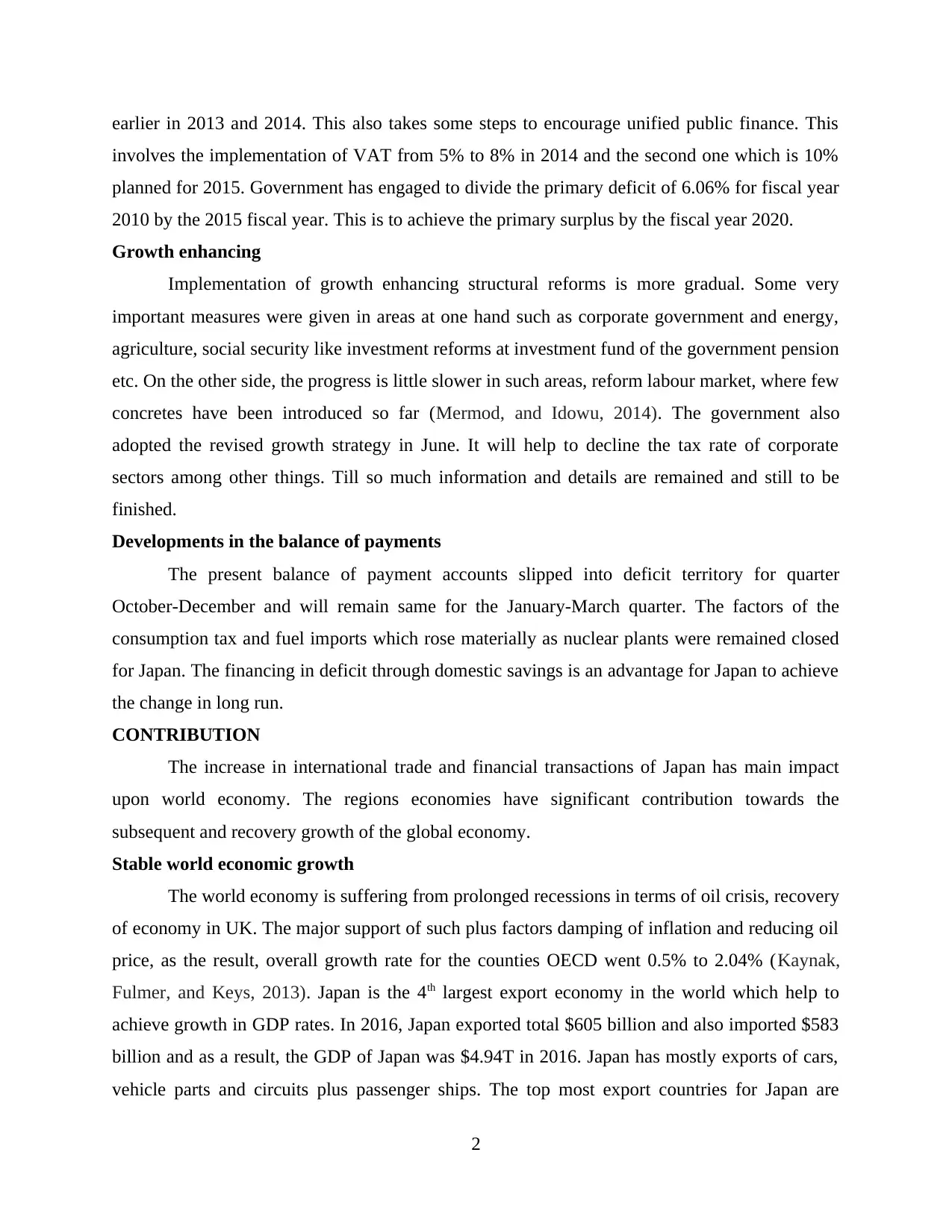
earlier in 2013 and 2014. This also takes some steps to encourage unified public finance. This
involves the implementation of VAT from 5% to 8% in 2014 and the second one which is 10%
planned for 2015. Government has engaged to divide the primary deficit of 6.06% for fiscal year
2010 by the 2015 fiscal year. This is to achieve the primary surplus by the fiscal year 2020.
Growth enhancing
Implementation of growth enhancing structural reforms is more gradual. Some very
important measures were given in areas at one hand such as corporate government and energy,
agriculture, social security like investment reforms at investment fund of the government pension
etc. On the other side, the progress is little slower in such areas, reform labour market, where few
concretes have been introduced so far (Mermod, and Idowu, 2014). The government also
adopted the revised growth strategy in June. It will help to decline the tax rate of corporate
sectors among other things. Till so much information and details are remained and still to be
finished.
Developments in the balance of payments
The present balance of payment accounts slipped into deficit territory for quarter
October-December and will remain same for the January-March quarter. The factors of the
consumption tax and fuel imports which rose materially as nuclear plants were remained closed
for Japan. The financing in deficit through domestic savings is an advantage for Japan to achieve
the change in long run.
CONTRIBUTION
The increase in international trade and financial transactions of Japan has main impact
upon world economy. The regions economies have significant contribution towards the
subsequent and recovery growth of the global economy.
Stable world economic growth
The world economy is suffering from prolonged recessions in terms of oil crisis, recovery
of economy in UK. The major support of such plus factors damping of inflation and reducing oil
price, as the result, overall growth rate for the counties OECD went 0.5% to 2.04% (Kaynak,
Fulmer, and Keys, 2013). Japan is the 4th largest export economy in the world which help to
achieve growth in GDP rates. In 2016, Japan exported total $605 billion and also imported $583
billion and as a result, the GDP of Japan was $4.94T in 2016. Japan has mostly exports of cars,
vehicle parts and circuits plus passenger ships. The top most export countries for Japan are
2
involves the implementation of VAT from 5% to 8% in 2014 and the second one which is 10%
planned for 2015. Government has engaged to divide the primary deficit of 6.06% for fiscal year
2010 by the 2015 fiscal year. This is to achieve the primary surplus by the fiscal year 2020.
Growth enhancing
Implementation of growth enhancing structural reforms is more gradual. Some very
important measures were given in areas at one hand such as corporate government and energy,
agriculture, social security like investment reforms at investment fund of the government pension
etc. On the other side, the progress is little slower in such areas, reform labour market, where few
concretes have been introduced so far (Mermod, and Idowu, 2014). The government also
adopted the revised growth strategy in June. It will help to decline the tax rate of corporate
sectors among other things. Till so much information and details are remained and still to be
finished.
Developments in the balance of payments
The present balance of payment accounts slipped into deficit territory for quarter
October-December and will remain same for the January-March quarter. The factors of the
consumption tax and fuel imports which rose materially as nuclear plants were remained closed
for Japan. The financing in deficit through domestic savings is an advantage for Japan to achieve
the change in long run.
CONTRIBUTION
The increase in international trade and financial transactions of Japan has main impact
upon world economy. The regions economies have significant contribution towards the
subsequent and recovery growth of the global economy.
Stable world economic growth
The world economy is suffering from prolonged recessions in terms of oil crisis, recovery
of economy in UK. The major support of such plus factors damping of inflation and reducing oil
price, as the result, overall growth rate for the counties OECD went 0.5% to 2.04% (Kaynak,
Fulmer, and Keys, 2013). Japan is the 4th largest export economy in the world which help to
achieve growth in GDP rates. In 2016, Japan exported total $605 billion and also imported $583
billion and as a result, the GDP of Japan was $4.94T in 2016. Japan has mostly exports of cars,
vehicle parts and circuits plus passenger ships. The top most export countries for Japan are
2
Paraphrase This Document
Need a fresh take? Get an instant paraphrase of this document with our AI Paraphraser
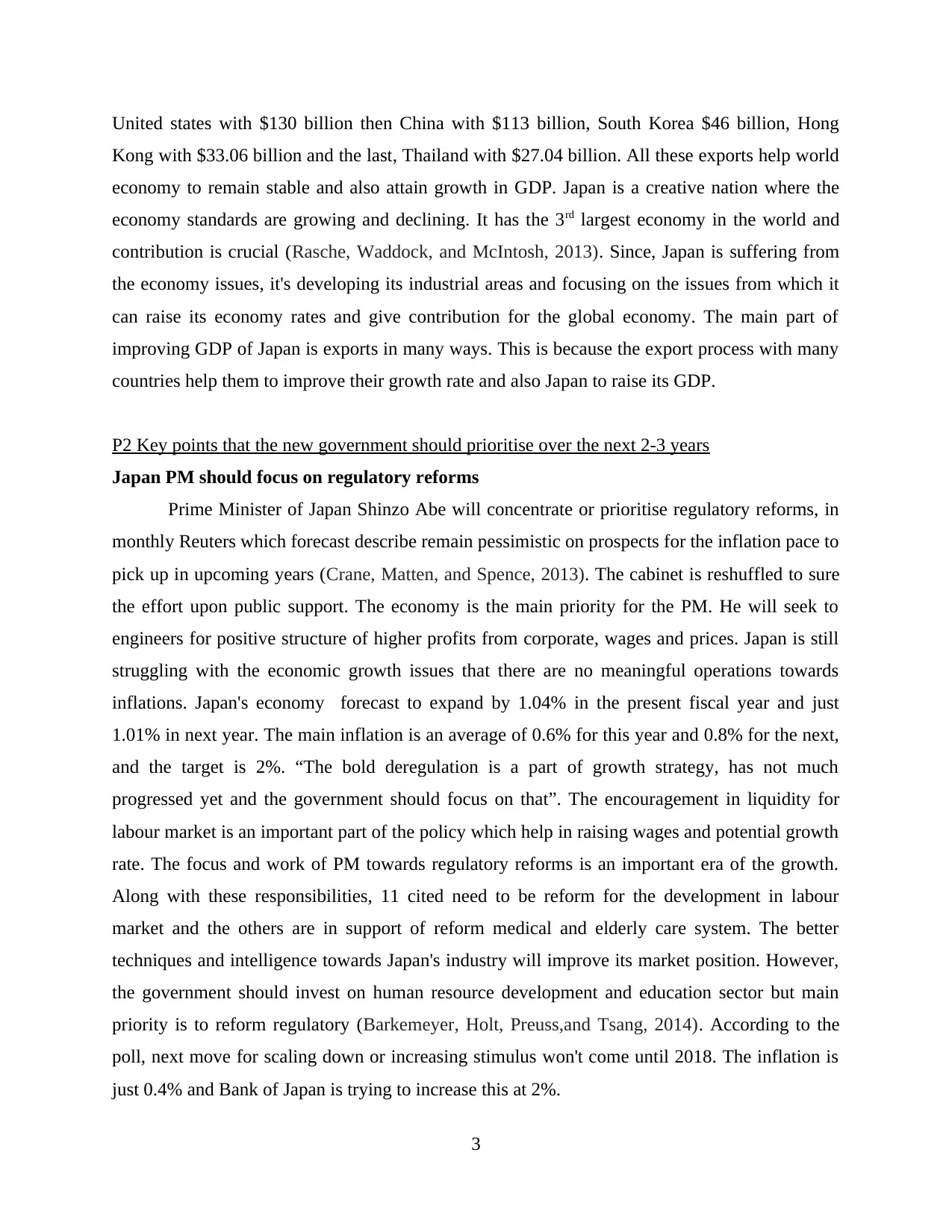
United states with $130 billion then China with $113 billion, South Korea $46 billion, Hong
Kong with $33.06 billion and the last, Thailand with $27.04 billion. All these exports help world
economy to remain stable and also attain growth in GDP. Japan is a creative nation where the
economy standards are growing and declining. It has the 3rd largest economy in the world and
contribution is crucial (Rasche, Waddock, and McIntosh, 2013). Since, Japan is suffering from
the economy issues, it's developing its industrial areas and focusing on the issues from which it
can raise its economy rates and give contribution for the global economy. The main part of
improving GDP of Japan is exports in many ways. This is because the export process with many
countries help them to improve their growth rate and also Japan to raise its GDP.
P2 Key points that the new government should prioritise over the next 2-3 years
Japan PM should focus on regulatory reforms
Prime Minister of Japan Shinzo Abe will concentrate or prioritise regulatory reforms, in
monthly Reuters which forecast describe remain pessimistic on prospects for the inflation pace to
pick up in upcoming years (Crane, Matten, and Spence, 2013). The cabinet is reshuffled to sure
the effort upon public support. The economy is the main priority for the PM. He will seek to
engineers for positive structure of higher profits from corporate, wages and prices. Japan is still
struggling with the economic growth issues that there are no meaningful operations towards
inflations. Japan's economy forecast to expand by 1.04% in the present fiscal year and just
1.01% in next year. The main inflation is an average of 0.6% for this year and 0.8% for the next,
and the target is 2%. “The bold deregulation is a part of growth strategy, has not much
progressed yet and the government should focus on that”. The encouragement in liquidity for
labour market is an important part of the policy which help in raising wages and potential growth
rate. The focus and work of PM towards regulatory reforms is an important era of the growth.
Along with these responsibilities, 11 cited need to be reform for the development in labour
market and the others are in support of reform medical and elderly care system. The better
techniques and intelligence towards Japan's industry will improve its market position. However,
the government should invest on human resource development and education sector but main
priority is to reform regulatory (Barkemeyer, Holt, Preuss,and Tsang, 2014). According to the
poll, next move for scaling down or increasing stimulus won't come until 2018. The inflation is
just 0.4% and Bank of Japan is trying to increase this at 2%.
3
Kong with $33.06 billion and the last, Thailand with $27.04 billion. All these exports help world
economy to remain stable and also attain growth in GDP. Japan is a creative nation where the
economy standards are growing and declining. It has the 3rd largest economy in the world and
contribution is crucial (Rasche, Waddock, and McIntosh, 2013). Since, Japan is suffering from
the economy issues, it's developing its industrial areas and focusing on the issues from which it
can raise its economy rates and give contribution for the global economy. The main part of
improving GDP of Japan is exports in many ways. This is because the export process with many
countries help them to improve their growth rate and also Japan to raise its GDP.
P2 Key points that the new government should prioritise over the next 2-3 years
Japan PM should focus on regulatory reforms
Prime Minister of Japan Shinzo Abe will concentrate or prioritise regulatory reforms, in
monthly Reuters which forecast describe remain pessimistic on prospects for the inflation pace to
pick up in upcoming years (Crane, Matten, and Spence, 2013). The cabinet is reshuffled to sure
the effort upon public support. The economy is the main priority for the PM. He will seek to
engineers for positive structure of higher profits from corporate, wages and prices. Japan is still
struggling with the economic growth issues that there are no meaningful operations towards
inflations. Japan's economy forecast to expand by 1.04% in the present fiscal year and just
1.01% in next year. The main inflation is an average of 0.6% for this year and 0.8% for the next,
and the target is 2%. “The bold deregulation is a part of growth strategy, has not much
progressed yet and the government should focus on that”. The encouragement in liquidity for
labour market is an important part of the policy which help in raising wages and potential growth
rate. The focus and work of PM towards regulatory reforms is an important era of the growth.
Along with these responsibilities, 11 cited need to be reform for the development in labour
market and the others are in support of reform medical and elderly care system. The better
techniques and intelligence towards Japan's industry will improve its market position. However,
the government should invest on human resource development and education sector but main
priority is to reform regulatory (Barkemeyer, Holt, Preuss,and Tsang, 2014). According to the
poll, next move for scaling down or increasing stimulus won't come until 2018. The inflation is
just 0.4% and Bank of Japan is trying to increase this at 2%.
3
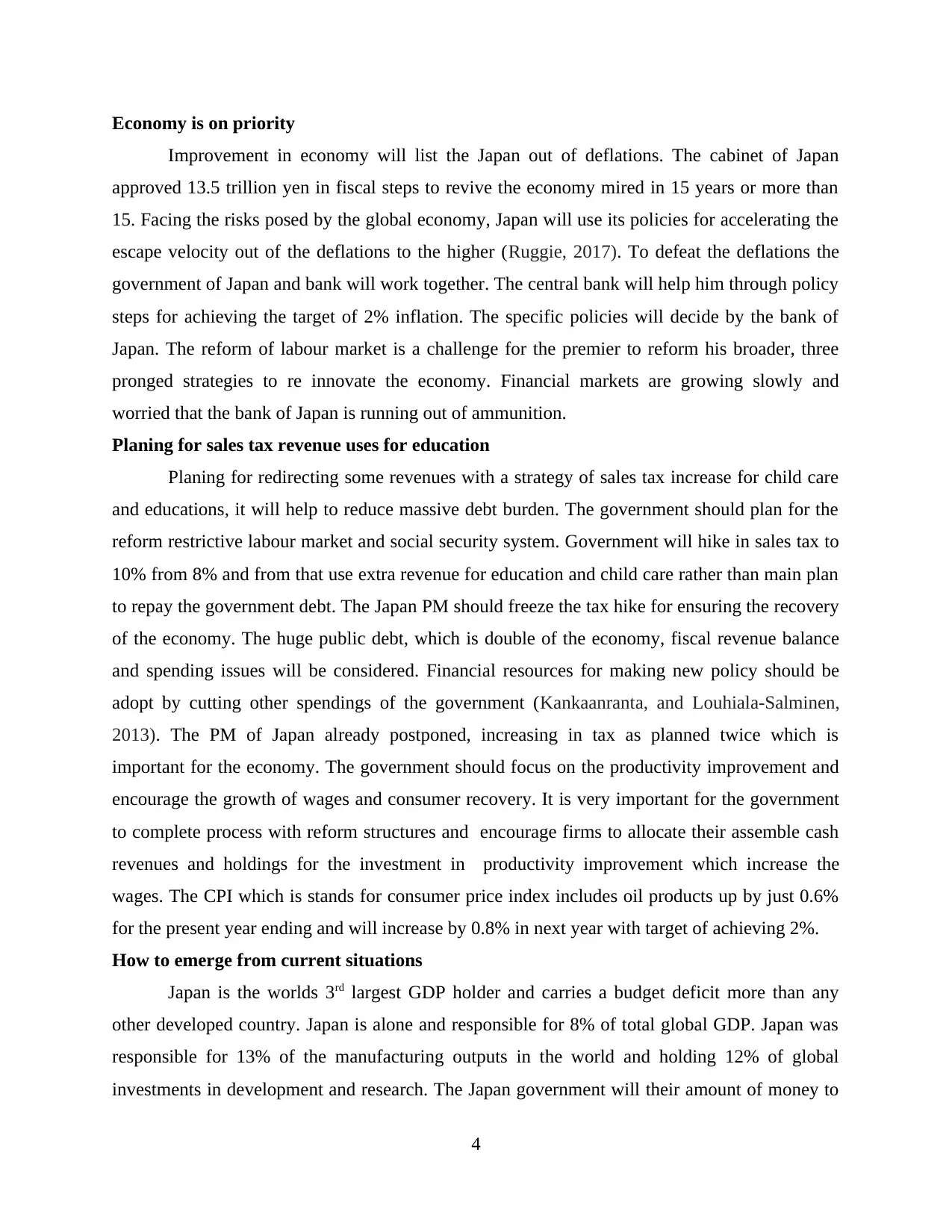
Economy is on priority
Improvement in economy will list the Japan out of deflations. The cabinet of Japan
approved 13.5 trillion yen in fiscal steps to revive the economy mired in 15 years or more than
15. Facing the risks posed by the global economy, Japan will use its policies for accelerating the
escape velocity out of the deflations to the higher (Ruggie, 2017). To defeat the deflations the
government of Japan and bank will work together. The central bank will help him through policy
steps for achieving the target of 2% inflation. The specific policies will decide by the bank of
Japan. The reform of labour market is a challenge for the premier to reform his broader, three
pronged strategies to re innovate the economy. Financial markets are growing slowly and
worried that the bank of Japan is running out of ammunition.
Planing for sales tax revenue uses for education
Planing for redirecting some revenues with a strategy of sales tax increase for child care
and educations, it will help to reduce massive debt burden. The government should plan for the
reform restrictive labour market and social security system. Government will hike in sales tax to
10% from 8% and from that use extra revenue for education and child care rather than main plan
to repay the government debt. The Japan PM should freeze the tax hike for ensuring the recovery
of the economy. The huge public debt, which is double of the economy, fiscal revenue balance
and spending issues will be considered. Financial resources for making new policy should be
adopt by cutting other spendings of the government (Kankaanranta, and Louhiala-Salminen,
2013). The PM of Japan already postponed, increasing in tax as planned twice which is
important for the economy. The government should focus on the productivity improvement and
encourage the growth of wages and consumer recovery. It is very important for the government
to complete process with reform structures and encourage firms to allocate their assemble cash
revenues and holdings for the investment in productivity improvement which increase the
wages. The CPI which is stands for consumer price index includes oil products up by just 0.6%
for the present year ending and will increase by 0.8% in next year with target of achieving 2%.
How to emerge from current situations
Japan is the worlds 3rd largest GDP holder and carries a budget deficit more than any
other developed country. Japan is alone and responsible for 8% of total global GDP. Japan was
responsible for 13% of the manufacturing outputs in the world and holding 12% of global
investments in development and research. The Japan government will their amount of money to
4
Improvement in economy will list the Japan out of deflations. The cabinet of Japan
approved 13.5 trillion yen in fiscal steps to revive the economy mired in 15 years or more than
15. Facing the risks posed by the global economy, Japan will use its policies for accelerating the
escape velocity out of the deflations to the higher (Ruggie, 2017). To defeat the deflations the
government of Japan and bank will work together. The central bank will help him through policy
steps for achieving the target of 2% inflation. The specific policies will decide by the bank of
Japan. The reform of labour market is a challenge for the premier to reform his broader, three
pronged strategies to re innovate the economy. Financial markets are growing slowly and
worried that the bank of Japan is running out of ammunition.
Planing for sales tax revenue uses for education
Planing for redirecting some revenues with a strategy of sales tax increase for child care
and educations, it will help to reduce massive debt burden. The government should plan for the
reform restrictive labour market and social security system. Government will hike in sales tax to
10% from 8% and from that use extra revenue for education and child care rather than main plan
to repay the government debt. The Japan PM should freeze the tax hike for ensuring the recovery
of the economy. The huge public debt, which is double of the economy, fiscal revenue balance
and spending issues will be considered. Financial resources for making new policy should be
adopt by cutting other spendings of the government (Kankaanranta, and Louhiala-Salminen,
2013). The PM of Japan already postponed, increasing in tax as planned twice which is
important for the economy. The government should focus on the productivity improvement and
encourage the growth of wages and consumer recovery. It is very important for the government
to complete process with reform structures and encourage firms to allocate their assemble cash
revenues and holdings for the investment in productivity improvement which increase the
wages. The CPI which is stands for consumer price index includes oil products up by just 0.6%
for the present year ending and will increase by 0.8% in next year with target of achieving 2%.
How to emerge from current situations
Japan is the worlds 3rd largest GDP holder and carries a budget deficit more than any
other developed country. Japan is alone and responsible for 8% of total global GDP. Japan was
responsible for 13% of the manufacturing outputs in the world and holding 12% of global
investments in development and research. The Japan government will their amount of money to
4
⊘ This is a preview!⊘
Do you want full access?
Subscribe today to unlock all pages.

Trusted by 1+ million students worldwide
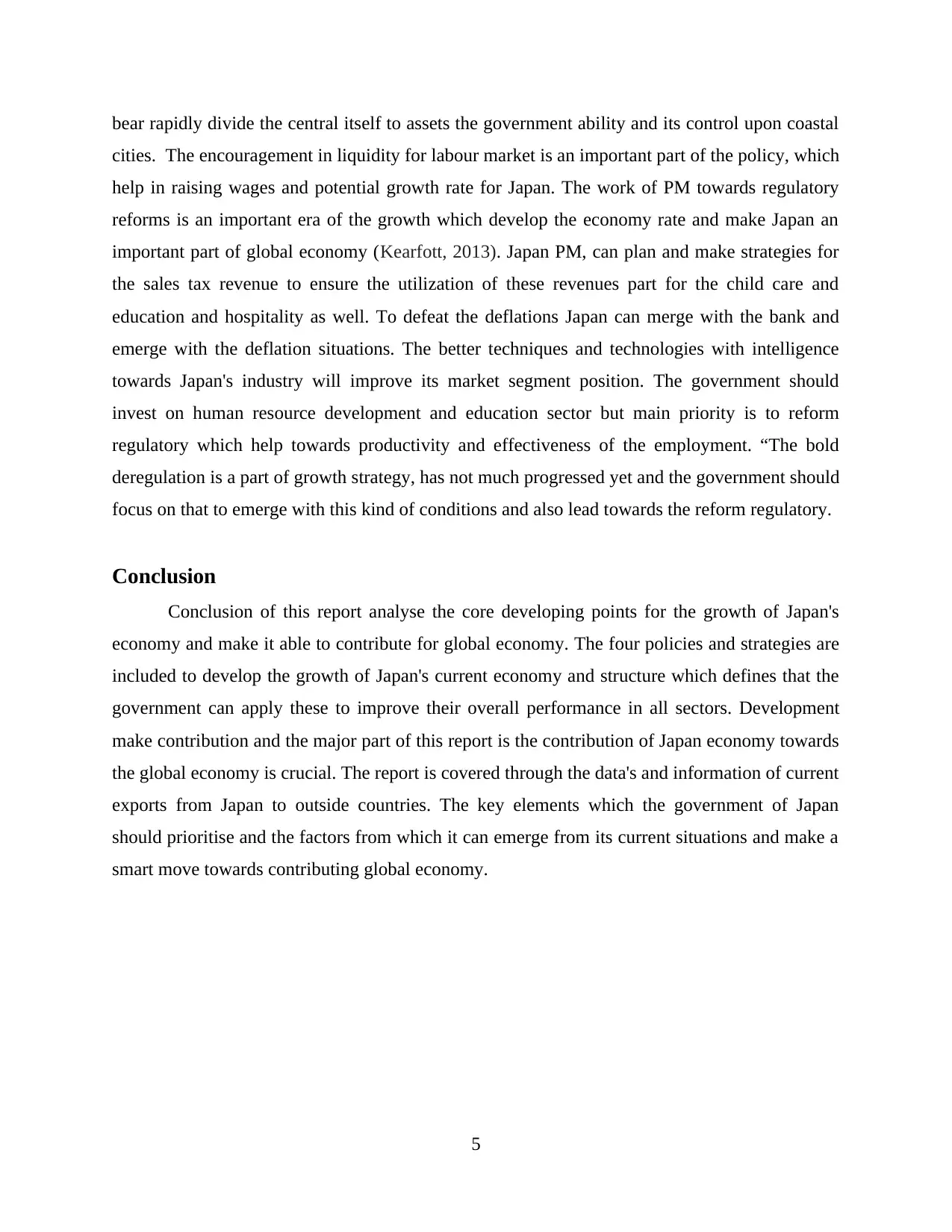
bear rapidly divide the central itself to assets the government ability and its control upon coastal
cities. The encouragement in liquidity for labour market is an important part of the policy, which
help in raising wages and potential growth rate for Japan. The work of PM towards regulatory
reforms is an important era of the growth which develop the economy rate and make Japan an
important part of global economy (Kearfott, 2013). Japan PM, can plan and make strategies for
the sales tax revenue to ensure the utilization of these revenues part for the child care and
education and hospitality as well. To defeat the deflations Japan can merge with the bank and
emerge with the deflation situations. The better techniques and technologies with intelligence
towards Japan's industry will improve its market segment position. The government should
invest on human resource development and education sector but main priority is to reform
regulatory which help towards productivity and effectiveness of the employment. “The bold
deregulation is a part of growth strategy, has not much progressed yet and the government should
focus on that to emerge with this kind of conditions and also lead towards the reform regulatory.
Conclusion
Conclusion of this report analyse the core developing points for the growth of Japan's
economy and make it able to contribute for global economy. The four policies and strategies are
included to develop the growth of Japan's current economy and structure which defines that the
government can apply these to improve their overall performance in all sectors. Development
make contribution and the major part of this report is the contribution of Japan economy towards
the global economy is crucial. The report is covered through the data's and information of current
exports from Japan to outside countries. The key elements which the government of Japan
should prioritise and the factors from which it can emerge from its current situations and make a
smart move towards contributing global economy.
5
cities. The encouragement in liquidity for labour market is an important part of the policy, which
help in raising wages and potential growth rate for Japan. The work of PM towards regulatory
reforms is an important era of the growth which develop the economy rate and make Japan an
important part of global economy (Kearfott, 2013). Japan PM, can plan and make strategies for
the sales tax revenue to ensure the utilization of these revenues part for the child care and
education and hospitality as well. To defeat the deflations Japan can merge with the bank and
emerge with the deflation situations. The better techniques and technologies with intelligence
towards Japan's industry will improve its market segment position. The government should
invest on human resource development and education sector but main priority is to reform
regulatory which help towards productivity and effectiveness of the employment. “The bold
deregulation is a part of growth strategy, has not much progressed yet and the government should
focus on that to emerge with this kind of conditions and also lead towards the reform regulatory.
Conclusion
Conclusion of this report analyse the core developing points for the growth of Japan's
economy and make it able to contribute for global economy. The four policies and strategies are
included to develop the growth of Japan's current economy and structure which defines that the
government can apply these to improve their overall performance in all sectors. Development
make contribution and the major part of this report is the contribution of Japan economy towards
the global economy is crucial. The report is covered through the data's and information of current
exports from Japan to outside countries. The key elements which the government of Japan
should prioritise and the factors from which it can emerge from its current situations and make a
smart move towards contributing global economy.
5
Paraphrase This Document
Need a fresh take? Get an instant paraphrase of this document with our AI Paraphraser
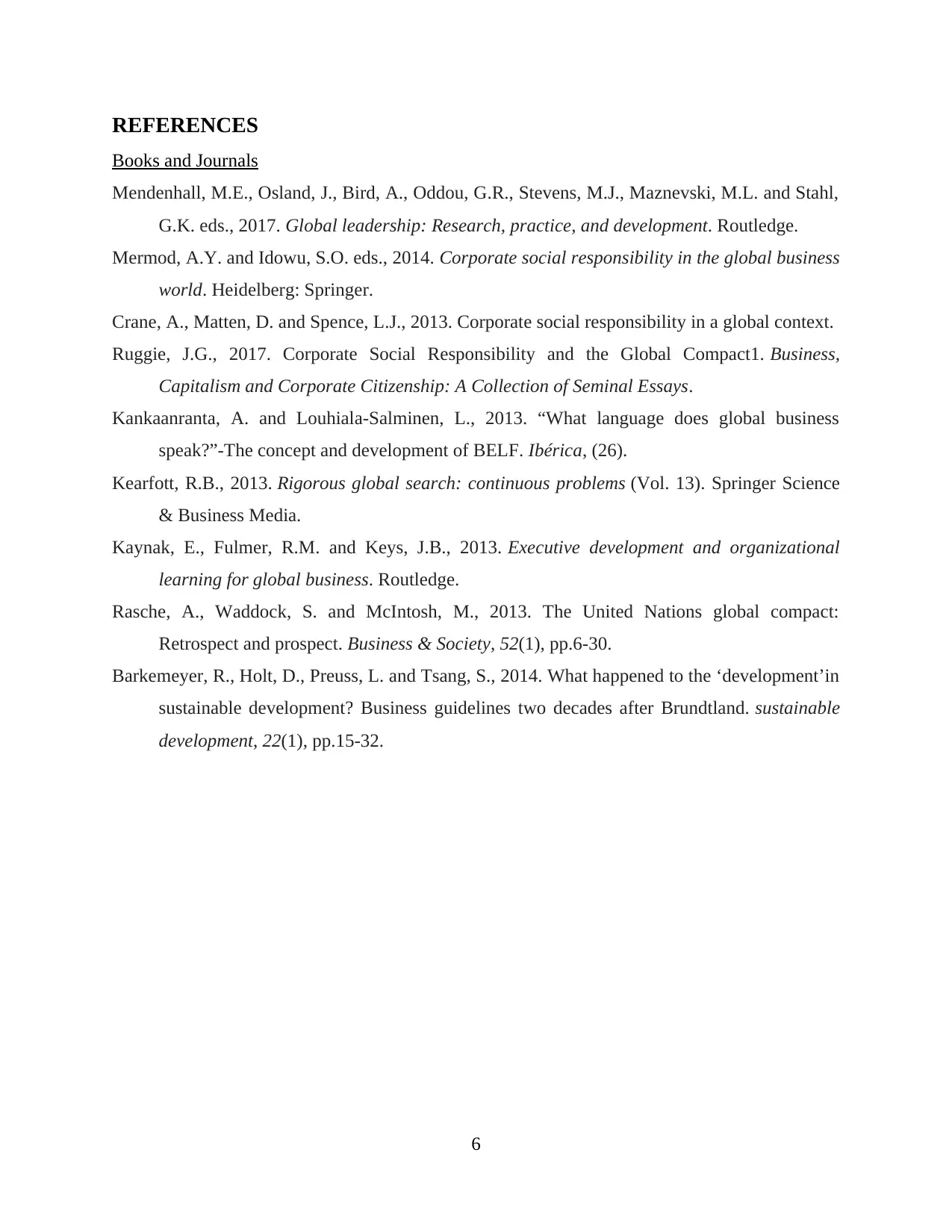
REFERENCES
Books and Journals
Mendenhall, M.E., Osland, J., Bird, A., Oddou, G.R., Stevens, M.J., Maznevski, M.L. and Stahl,
G.K. eds., 2017. Global leadership: Research, practice, and development. Routledge.
Mermod, A.Y. and Idowu, S.O. eds., 2014. Corporate social responsibility in the global business
world. Heidelberg: Springer.
Crane, A., Matten, D. and Spence, L.J., 2013. Corporate social responsibility in a global context.
Ruggie, J.G., 2017. Corporate Social Responsibility and the Global Compact1. Business,
Capitalism and Corporate Citizenship: A Collection of Seminal Essays.
Kankaanranta, A. and Louhiala-Salminen, L., 2013. “What language does global business
speak?”-The concept and development of BELF. Ibérica, (26).
Kearfott, R.B., 2013. Rigorous global search: continuous problems (Vol. 13). Springer Science
& Business Media.
Kaynak, E., Fulmer, R.M. and Keys, J.B., 2013. Executive development and organizational
learning for global business. Routledge.
Rasche, A., Waddock, S. and McIntosh, M., 2013. The United Nations global compact:
Retrospect and prospect. Business & Society, 52(1), pp.6-30.
Barkemeyer, R., Holt, D., Preuss, L. and Tsang, S., 2014. What happened to the ‘development’in
sustainable development? Business guidelines two decades after Brundtland. sustainable
development, 22(1), pp.15-32.
6
Books and Journals
Mendenhall, M.E., Osland, J., Bird, A., Oddou, G.R., Stevens, M.J., Maznevski, M.L. and Stahl,
G.K. eds., 2017. Global leadership: Research, practice, and development. Routledge.
Mermod, A.Y. and Idowu, S.O. eds., 2014. Corporate social responsibility in the global business
world. Heidelberg: Springer.
Crane, A., Matten, D. and Spence, L.J., 2013. Corporate social responsibility in a global context.
Ruggie, J.G., 2017. Corporate Social Responsibility and the Global Compact1. Business,
Capitalism and Corporate Citizenship: A Collection of Seminal Essays.
Kankaanranta, A. and Louhiala-Salminen, L., 2013. “What language does global business
speak?”-The concept and development of BELF. Ibérica, (26).
Kearfott, R.B., 2013. Rigorous global search: continuous problems (Vol. 13). Springer Science
& Business Media.
Kaynak, E., Fulmer, R.M. and Keys, J.B., 2013. Executive development and organizational
learning for global business. Routledge.
Rasche, A., Waddock, S. and McIntosh, M., 2013. The United Nations global compact:
Retrospect and prospect. Business & Society, 52(1), pp.6-30.
Barkemeyer, R., Holt, D., Preuss, L. and Tsang, S., 2014. What happened to the ‘development’in
sustainable development? Business guidelines two decades after Brundtland. sustainable
development, 22(1), pp.15-32.
6
1 out of 8
Related Documents
Your All-in-One AI-Powered Toolkit for Academic Success.
+13062052269
info@desklib.com
Available 24*7 on WhatsApp / Email
![[object Object]](/_next/static/media/star-bottom.7253800d.svg)
Unlock your academic potential
Copyright © 2020–2025 A2Z Services. All Rights Reserved. Developed and managed by ZUCOL.





